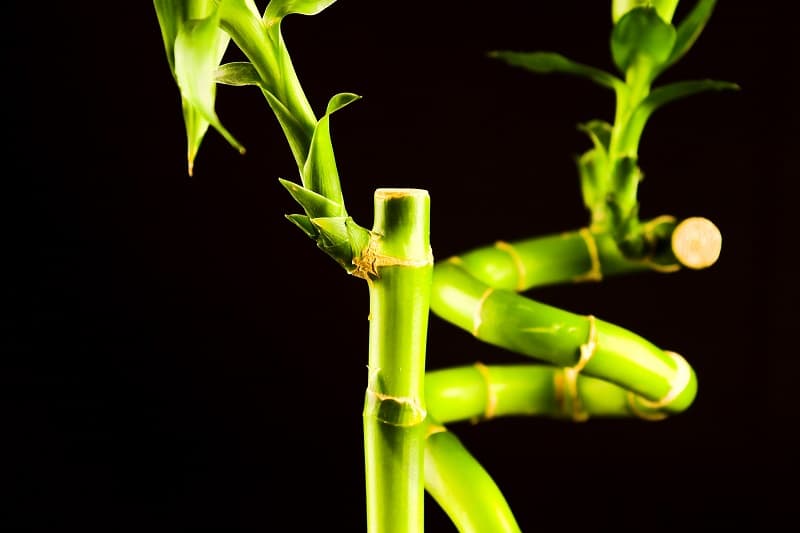
The lucky bamboo plant, Dracaena sanderiana of the family Asparagaceae, was named after the German-English gardener Henry Frederick Conrad Sander. According to Chinese beliefs, this household plant increases feng shui. The lucky bamboo plant is easy to grow in either water or soil and prefers indirect sunlight, but it can also be prone to yellowing and discoloration.
Lucky Bamboo Turning Yellow: Common Reasons
Here are some common reasons a lucky bamboo plant may turn yellow:
1. It could be due to exposure to chemicals in tap water.
Chlorine and fluoride, which are commonly present in tap water, can be dangerous for your lucky bamboo plant. These chemicals are harmful to plants and constant exposure could lead to yellowing and death for your plants.
Solution: Use filtered, spring, distilled or rainwater for your lucky bamboo plant. If you have a garden and you grow the plant outdoors, it is ideal to have a rainwater collecting system, provided it does not travel over an asphalt roof. Also, never use cold water; only water with room-temperature water.
Make sure to change the water every seven to 10 days and avoid stagnant water. Old water attracts fungus, bacteria and mold, so throw it away. If the water turns green, dark, cloudy or murky, or if it smells foul, then change the water at once.
2. It could be due to exposure to direct sunlight.
Lucky bamboo cannot thrive in direct sunlight, so if it is in full sun you need to move it to a shaded area. Too little indirect light could also make the plant weak and it will turn yellow or pale.
Solution: Place your plant near a window but out of direct sunlight. Popular areas for lucky bamboo plants include the kitchen counter, near a window, or on a table near a window. Make sure it is not exposed to direct sunlight since the sun’s rays will burn the plant.
3. It could be due to overwatering.
Lucky bamboo plants like moist soil, but soil that is too wet could result in yellowing. As with most plants, see to it that there is just enough moisture in the soil.
Solution: Keep your plants in moist soil. Add rocks on top of the soil which should maintain moderate moistness. Check the moistness of the soil by sticking your forefinger into the soil up to one inch; if it feels dry you need to water the plants. If the plants are in a soil bed, mist the leaves every two to three days to maintain their health.
4. It could be due to overfertilization.
Too much fertilizer could cause your lucky bamboo plants to yellow.
Solution: Change the water and move the plant to an area with less light. Avoid fertilizing the plant for a while.
5. It could be due to fungal growth or pests.
If you notice white or grey spots, this could suggest fungal growth or even pests.
Solution: Clean the infected parts with soap and water or alcohol solution. Use a cotton swab to gently wipe the plant.
Other than those mentioned above, you may try the following to prevent the plant from turning yellow:
- Use filtered water instead of tap water.
- Re-pot the plant to a fresh container.
- Change any pebbles that were infected with fungus or pests.
Facts About the Lucky Bamboo Plant
These are some interesting facts about lucky bamboo:
- The plant originated from Southeast Asia.
- It has been popularly used in the practice of Feng Shui for almost 5,000 years.
- The plant is said to bring health, love and luck to those who own it.
- The leaves of the lucky bamboo plant can grow up to one inch per month.
- The plant has naked branches that end in tufts of thin leaves, developing into plant stalks as they age. Once the stalks are cut, they will not grow taller. As the stalks develop, the plants can be manipulated into shapes using wires.
- Stalks can be clipped at the base and placed in distilled water to propagate more. The parent stalk grows more leaf sprouts and continues the cycle.
- Lucky bamboo plants thrive well in a container with one inch of distilled or purified water, and should be placed in a corner of the home for positive energy, prosperity and good fortune.
Lucky Bamboo Plant Care
Lucky bamboo plants could last for up to two years in water, but they grow better and longer when planted in soil. The plants will wither if over- or underwatered, so always keep the soil slightly damp. Use small amounts of fertilizer or pesticide for plant support.
If you keep the plants in water, the roots should be under the water. Be sure to replace the water every seven to 10 days. Use filtered water instead of tap water which contains chlorine and fluoride that are toxic for plants.
Lucky bamboo plants prefer temperatures ranging from 65 to 95 degrees Fahrenheit. Keep them away from windows and drafts during wintertime. Also, do not place them in direct sunlight as they could develop sunburn. Move the plants to partial shade if the leaves become brown and only expose the plant to indirect sunlight in the morning.
Keep the plants away from pets, since the leaves and plant parts are toxic for animals.
Conclusion
Lucky bamboo turning yellow could be attributed to overwatering or exposure to chemicals in tap water. They may also be turning yellow because of fungal growth, pest infestation and exposure to direct sunlight.
Image: istockphoto.com / NickS